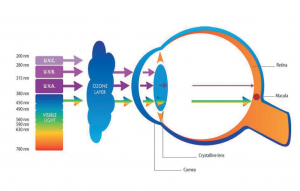Just like using sunscreen for our skin, our eyes need protection too as damage caused by ultraviolet (UV) rays is harmful

Too much exposure to ultraviolet (UV) rays mostly from sunlight, is known to be harmful. Apart from harming the skin, our eyes are also the most susceptible organ that can be damaged by UV radiation.
Optometrist Su Zhei Yuen from I-Focus Mid Valley said: “We need sunlight but too much exposure to UV rays is harmful and it can cause eye damage and effect our vision.”
Dangers of UV exposure
She explained that the sun emits three different types of UV rays – UVA, UVB and UVC.
“UVA rays can pass through our cornea and reach the lens and retina easily and can potentially lead to eye diseases such as cataract and macular degeneration. UVB rays on the other hand are more harmful to the surface of the eye, which can cause diseases such as pterygium and photokeratitis. UVC, the most harmful ray, fortunately is mostly blocked by the ozone layer.”

According to Su, exposure to UV rays depends on two factors – environmental and personal.
“Environmental factors are the altitude, geography and cloud cover while personal factors include the nature of outdoors activities and also indoors activities with gadgets and certain lamps.
“There is a misconception that UV rays in the morning are not strong. On the contrary, around nine or 10 in the morning, 2pm is when the UV damage is at the highest.
“Also, many people are unaware that lights from lamps and gadgets like smartphones and laptops emit certain levels of UV rays.”
In some cases, said Su, there are individuals under photosensitising medications or drugs such as tetracycline, birth control pills and diuretics are at higher risk of UV damage and may contribute to cataract progression.
“For some long-term eye problems that result from UV rays, there is no way to reverse them. It depends on the severity of the UV damage. Usually for conditions like cataract and pterygium, surgical interventions are needed.”
Prevention is better that cure
Just like using sunscreen for the skin, our eyes need protection too and as damage caused by UV is cumulative, it is important to protect the eyes from an early age.
“Children are more susceptible to UV damage than adults because their eye lenses are much clearer which allows the UV rays to reach the retina easier.
Protection tips shared by Su include:
- Wearing spectacles,sunglasses or contact lenses with UV protection.
- Wear a brimmed hat or caps to prevent peripheral UV rays
- Get regular eye examination.
“Usually for short term exposure to UV light, one may get photokeratitis, which is sun burn of the eye. It may cause painful or stinging feelings, but usually resolves on its own within a day or two.”
Su also shared some tips for those experiencing discomfort in their eyes.
“Avoid rubbing the eyes and try cold compress. For those contact lens wearers, remove the contact lenses immediately. It is also best to skip wearing makeup.
“If needed, you can seek the help of medical practitioners for antibiotics or pain-relieving eye drops.
“However, if the symptoms worsen – seeing halos, distortion of vision or night vision problems – it is advisable to see eye care practitioners or specialists.”
UV protection glasses and lenses
UV protection glasses and contact lenses are able to block certain levels of UV light depending on the type.
“UV blocking lenses absorb UV thus limiting the amount of UV reaching the surface of the eyes. It reduces the risk of eye disease such as pterygium.”
According to Su, not all glasses or contact lenses have UV protection and while some of them may have UV protection, it may be inadequate.
“And the most effective level of protection for our eyes from UV rays is achieved with a combination of UV blocking spectacles or sunglasses, a wide-brimmed hat and UV blocking contact lenses.
“In this market, Acuvue brand contact lens is a major brand which blocks at least 97 per cent of UVB and 81 per cent of UVA.”
All Acuvue brand contact lens offer FDA approved UV protection to help provide protection against transmission of harmful UV radiation to the cornea and into the eye.
Safe contact lenses
When it comes to purchasing contact lenses, Su stressed that it is important to look for FDA approved UV protection contact lenses.
“FDA approved contact lenses ensure safety for human use. There are two classes of FDA approval for UV protection contact lenses. FDA Class 1 blocks 90 per cent UVA and 99 per cent UVB while and FDA Class 2 blocks 70 per cent UVA and 95 per cent UVB.”
Another aspect of contact lens safety is wearing the right contact lens diameter which fits well for long term eye health safety.
An ideal fitting of soft contact lenses contributes to comfort, a clear and stable vision, is aligned at the center and has adequate contact lens movement for tear exchange.
“So, it is recommended to get an eye care practitioner’s advice for well fitted FDA approved UV protection contact lenses.”
I-Focus Midvalley

Su, who is also the branch manager of I-Focus Mid Valley, shared that comprehensive eye examination not only determines if you need glasses or contact lenses, but also helps examine the wide aspects of eye health.
“Our practice at I-Focus Mid Valley is a new concept store with comprehensive eye examinations with the latest state-of-art technology with dedicated eye care practitioners.”
Among the equipment available at I-Focus Mid Valley is a WAM analyzer, which is used for screening not only
power but the eye health condition such as IOP and clarity of lens, fundoscopy for retina examination, topography for contact lens fitting and dry eye assessment and the latest phoropter vision 800 for more precise subjective refraction which also ensures comfort. — The Health







